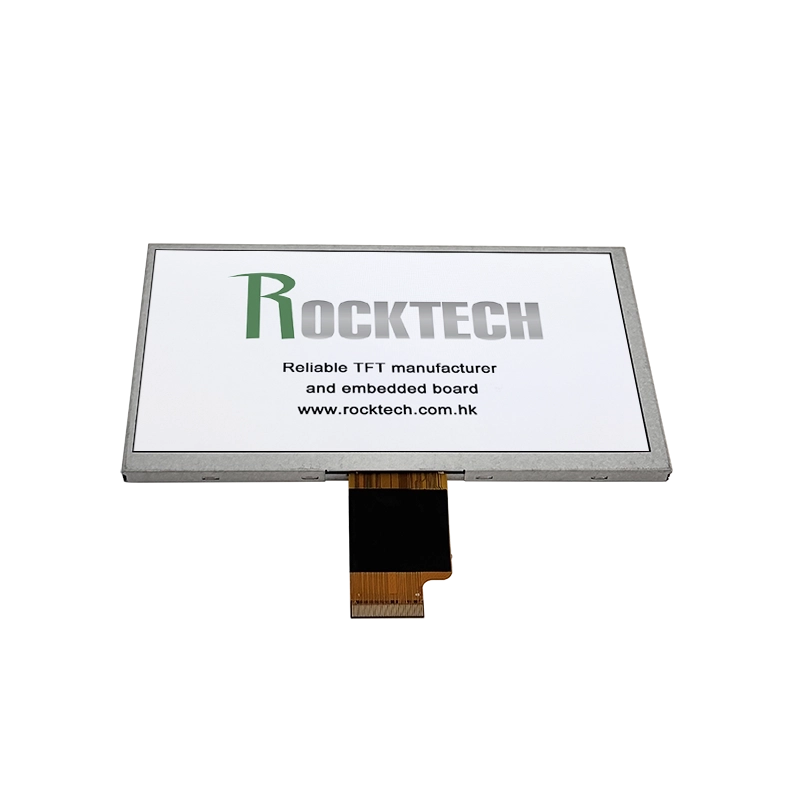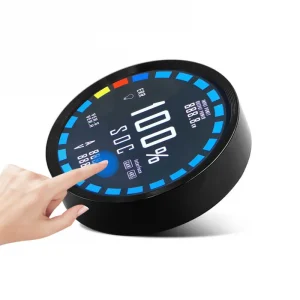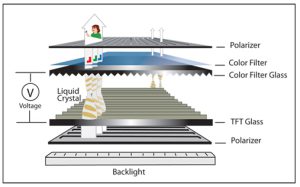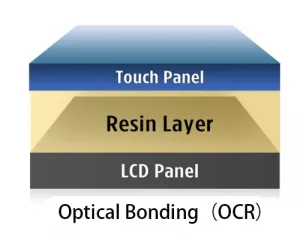In the comparison of IPS vs OLED display technologies, the right choice can define the performance of modern industrial systems. From healthcare to transportation, understanding the differences between IPS and OLED is crucial for reliability and long-term usability.
In this article, we will explore IPS vs OLED display technologies to help industrial engineers and system integrators make the best decision.
Understanding IPS and OLED Technology
IPS Displays
IPS panels use liquid crystal molecules aligned in parallel to deliver wide viewing angles, consistent brightness, and exceptional color accuracy. These qualities make IPS displays a mainstay for industrial systems requiring high reliability. They offer excellent stability under extreme temperatures (-30°C to +85°C), superior sunlight readability (up to 1500 nits), and an operational life of up to 70,000 hours. These characteristics make IPS vs OLED a critical decision point for industrial users.
OLED Displays
OLED displays rely on electroluminescent organic layers to create light. Each pixel emits its own illumination, producing perfect blacks and stunning contrast ratios. OLEDs enable thinner, more flexible screens, which makes them desirable for innovative form factors. However, their shorter lifespan (30,000–50,000 hours) and risk of image burn-in limit their use in continuous industrial operations. While OLED offers great visual impact, IPS vs OLED comparisons often highlight IPS as more suitable for industrial longevity.
Performance Comparison: IPS vs OLED
The table below offers a side-by-side comparison of IPS vs OLED across critical performance metrics. Understanding these differences is essential for selecting the right display for industrial needs.
| Feature | IPS | OLED |
|---|---|---|
| Color Accuracy | Excellent | Exceptional |
| Viewing Angles | 178° Wide | 178° Wide |
| Contrast Ratio | 1000:1 | Infinite |
| Response Time | 4–5 ms | 0.1–1 ms |
| Brightness | Up to 1500 nits | 500–700 nits |
| Power Consumption | Stable | Varies (dark content saves power) |
| Burn-in Risk | None | Possible |
| Cost | Lower | Higher |
| Lifespan | Up to 70,000 hours | 30,000–50,000 hours |
| Flexibility | Rigid Glass | Flexible, Bendable |
Industrial Application Considerations
This is another key consideration when evaluating IPS vs OLED for industrial use.
- Longevity: IPS excels for 24/7 operation such as in control panels, outdoor kiosks, and vehicle displays.
- Brightness: IPS’s high luminance makes it ideal for direct-sunlight industrial uses.
- Temperature Tolerance: IPS maintains performance under harsh conditions from oil rigs to mining equipment.
- Cost Efficiency: IPS displays offer a better cost-to-lifespan ratio for industrial clients and system integrators.
- OLED Niche: OLED fits niche markets such as premium handheld diagnostic tools and compact wearable devices.
Real-World Industrial Use Cases
Transportation Systems
Railway station information boards, bus displays, and air traffic control panels rely on IPS for their durability and brightness. OLED displays, while rarely used in large outdoor signage due to brightness limitations, are sometimes used in high-end in-vehicle displays.In transportation environments, IPS vs OLED shows a clear preference for IPS due to better readability and durability.
Energy Monitoring
Industrial energy plants and smart grid stations prefer IPS displays for continuous performance and superior readability in extreme conditions. OLED displays are not commonly used here because of potential burn-in and temperature sensitivity.
Healthcare Equipment
Medical imaging systems, surgical displays, and patient monitoring devices demand IPS for consistent color accuracy and wide viewing angles critical in healthcare. OLED can be found in handheld diagnostic devices where flexibility and size are prioritized.This again highlights IPS vs OLED as a tradeoff between precision visuals and long-term usage stability.
Industrial Automation
Factory control panels and human-machine interfaces (HMI) favor IPS because of its resilience in extreme environments and continuous operational reliability. OLED is sometimes used in handheld controllers where contrast and compact form factors are needed.
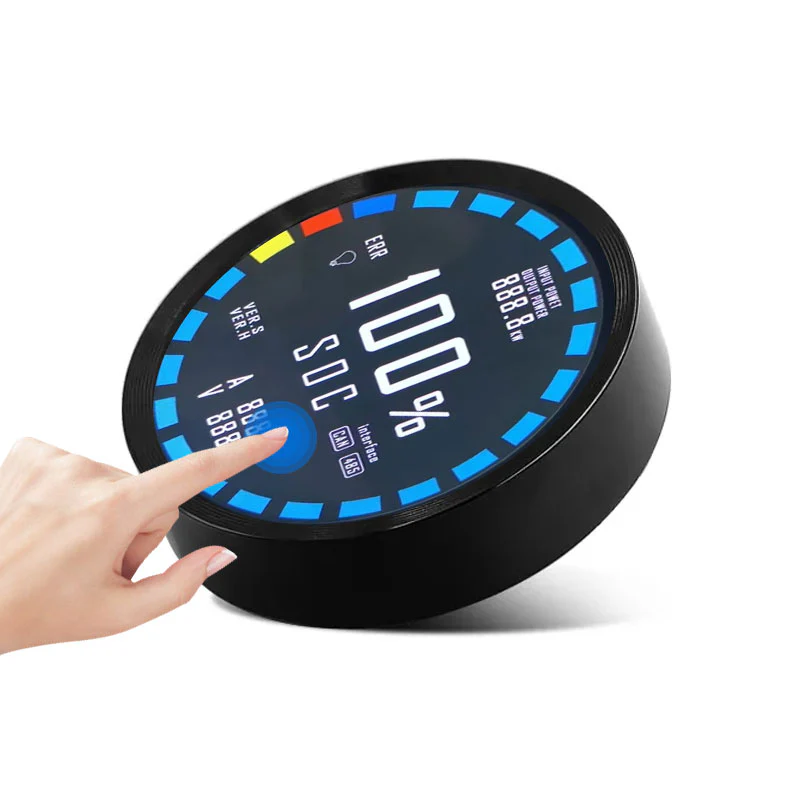
Interactive smart control knob with 2.1” IPS round TFT display, designed for modern interfaces
Which Display Should You Choose?
Based on your project’s needs, this IPS vs OLED decision matrix can guide you toward the right display solution.
| If your priority is: | Recommended |
|---|---|
| Continuous 24/7 use | IPS |
| Sunlight readability | IPS |
| Extreme temperature performance | IPS |
| Portable ultra-thin design | OLED |
| No risk of burn-in | IPS |
| Maximum contrast for handhelds | OLED (with caution) |
Future Trends in Industrial Display Technology
As industries demand more compact, efficient, and intelligent display technologies, the boundary between IPS and OLED is becoming more defined by their specialized uses.
Advancements in IPS
IPS technology continues to improve in brightness levels, energy efficiency, and durability. Manufacturers are working on IPS panels that can withstand even wider operating temperature ranges, improved outdoor readability, and enhanced touch sensitivity. IPS remains the gold standard for applications where reliability, lifespan, and cost are the primary concerns.
Emergence of OLED Innovations
OLED technology is also advancing rapidly. Flexible OLED panels are now being tested in industrial wearables, foldable equipment screens, and advanced portable measurement tools. Emerging improvements in material stability aim to extend OLED lifespans and reduce burn-in risks, potentially opening up more possibilities for industrial adoption.
The Rise of Hybrid Solutions
Researchers and manufacturers are exploring hybrid solutions, combining IPS backplanes with OLED overlays or creating novel composite display stacks that balance the strengths of both technologies. These innovations could offer the flexibility of OLED with the robustness of IPS. As hybrid technologies evolve, engineers may find new ways to blend IPS vs OLED advantages for smarter deployments.
Conclusion
For industrial clients, IPS remains the dominant choice due to its longevity, stability, brightness, wide temperature tolerance, and lower total cost of ownership. From transportation and energy monitoring to healthcare and factory automation, IPS panels deliver proven performance under demanding conditions.
OLED displays shine in niche high-end design cases where flexibility, size reduction, or extreme contrast are desired but longevity is less critical. Their ability to provide stunning visuals with true blacks makes them suitable for specific portable and wearable device applications.
When selecting the optimal display solution for your industrial application, it is crucial to assess not only the technical performance but also the environmental demands, operating hours, and long-term maintenance expectations.Ultimately, IPS vs OLED is a core decision every industrial display designer must make. With this comparison guide, we hope you can select the best-fit technology for your application.
Contact us at Rocktech to discuss your industrial display requirements and receive expert consultation on IPS, OLED, and custom industrial display modules. Our engineers are ready to help you select the perfect solution tailored to your unique application needs.
Frequently Asked Questions (FAQ)
1. Why do many industrial users prefer IPS vs OLED displays?
IPS displays offer excellent durability, superior color accuracy, high brightness, wide operating temperatures, and a long operational life. These attributes make them ideal for 24/7 industrial environments like manufacturing plants, transportation systems, and energy monitoring stations.
2. Can OLED displays be used in industrial environments?
OLED displays can be used in select industrial applications where compact size, flexibility, or stunning contrast are critical. However, OLED panels are more sensitive to temperature, have shorter lifespans, and can suffer from image retention or burn-in under continuous usage.
3. Are there hybrid display solutions available?
Yes, some emerging display solutions combine IPS and OLED technologies to balance robustness with flexibility and visual performance. These are still in early adoption phases and are not yet widespread in industrial applications.
4. How does sunlight readability compare between IPS and OLED?
IPS displays outperform OLED in outdoor and high-brightness environments. IPS panels can achieve up to 1500 nits, making them highly sunlight-readable, whereas OLED displays typically max out around 700 nits.
5. Is there any maintenance difference between IPS and OLED displays?
IPS displays generally require less maintenance due to their robustness and lack of burn-in risk. OLED displays may require more careful usage to avoid static image retention and premature degradation of organic materials.
Get Expert Assistance
At Rocktech, we understand the complexities of selecting the right display technology for industrial projects. Our expert team provides full support from concept to mass production, including customized display modules tailored to your requirements.

